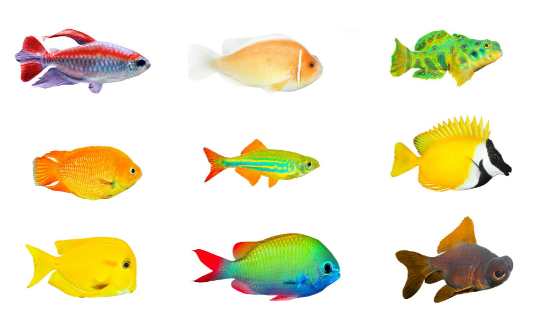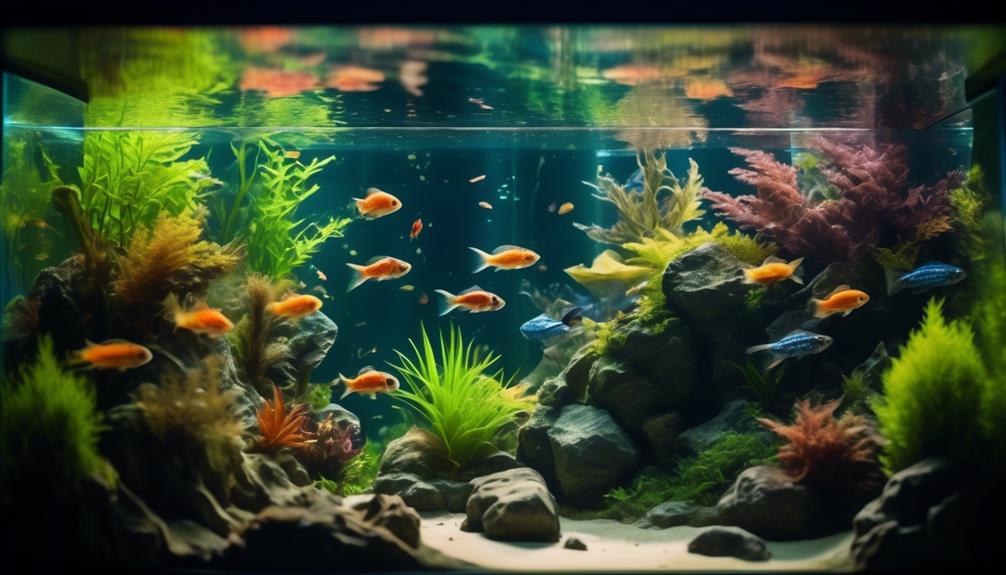
Did you know that creating a vibrant and natural habitat for your fish can be as simple as setting up a biotope tank? These specialized tanks replicate the diverse ecosystems of rivers and lakes from around the world, allowing your fish to thrive and display their natural behaviors.
But what exactly are the secrets behind these biotope tanks? How do they enhance the well-being of your fish and create visually stunning displays?
In this discussion, we will unveil the secrets of biotope tanks, revealing the key elements that make them so effective in creating vibrant fish habitats. So get ready to dive into the world of biotope tanks and discover how they can transform your fishkeeping experience.
Key Takeaways
- Biotope tanks mimic specific natural environments and provide a natural and realistic habitat for fish.
- Biotope tanks promote the well-being and health of fish by reducing stress and improving fish behavior.
- Biotope tanks create visually appealing and natural-looking displays, enhancing the overall aesthetic of the aquarium.
- Researching and understanding the specific needs of fish species and their natural habitats is crucial for setting up and maintaining a successful biotope tank.
The Importance of Biotope Tanks
Biotope tanks play a crucial role in creating a natural and enriching environment for fish. By mimicking specific natural habitats, these tanks provide a realistic and stimulating habitat for fish to thrive in. The importance of biotope tanks lies in their ability to recreate the natural behaviors and interactions of fish, reducing stress and improving overall fish behavior.
These tanks also offer educational opportunities to learn about different ecosystems and promote responsible fishkeeping and conservation efforts. When setting up a biotope tank, it’s essential to research the specific natural environment you want to replicate, select appropriate fish species and plants, and mimic the water parameters and conditions of the natural habitat.
Creating a Natural Habitat
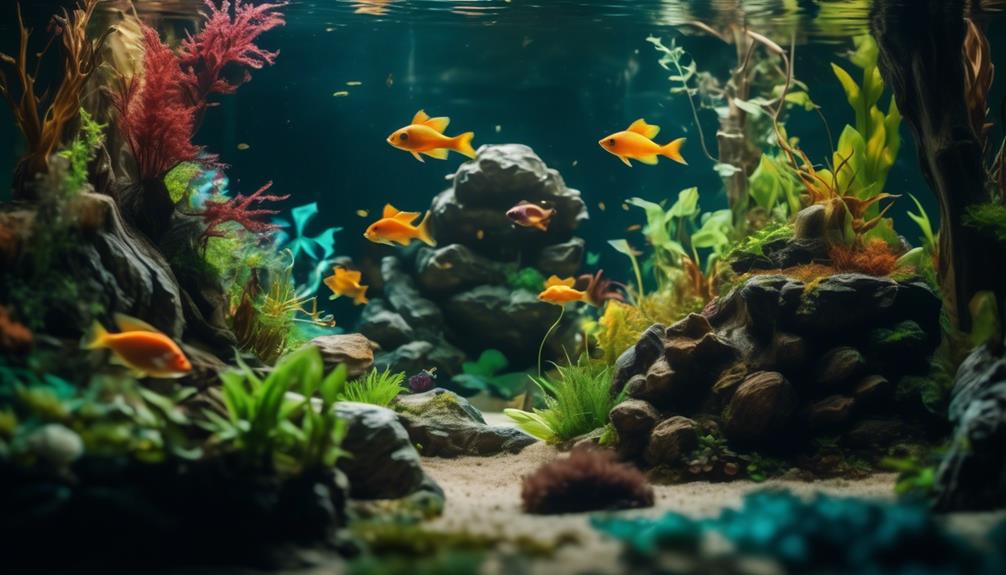
To create a natural habitat for your fish, carefully select appropriate elements that mimic the specific environment you want to replicate.
1) Research the natural environment you want to recreate in your tank. Understand the water parameters, temperature, and conditions that are characteristic of that habitat.
2) Choose fish species and plants that are native to the environment you’re replicating. This will ensure that they’re well-suited to the specific water conditions and can thrive in your tank.
3) Select suitable substrate, rocks, and decorations that resemble the natural habitat. This will provide hiding places, breeding areas, and a sense of familiarity for your fish.
Enhancing Fish Behavior and Well-being
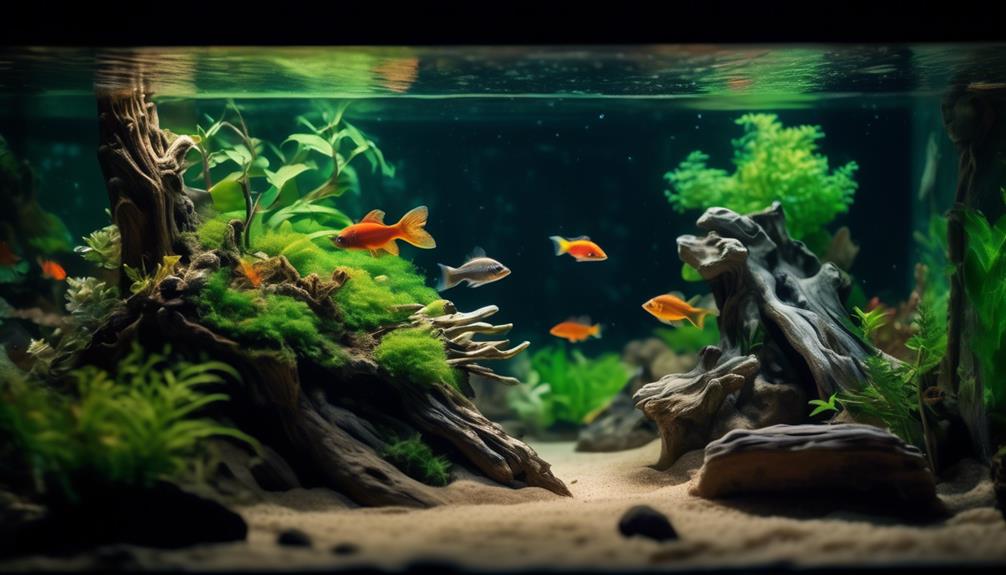
Enhancing the behavior and well-being of your fish can be achieved by providing a natural and stimulating environment. Creating a biotope tank that mimics their natural habitat is key. By replicating the specific water parameters, substrate, and decorations found in their natural environment, you can help reduce stress and improve their overall behavior.
Research the specific needs of your fish species and select appropriate tank mates to ensure a harmonious community. Providing hiding places, caves, and plants will give them opportunities for exploration and shelter.
Additionally, offering a varied diet that mimics their natural food sources will contribute to their overall health and well-being. Regularly monitoring and maintaining water parameters, performing water changes, and pruning plants will help ensure a thriving and vibrant biotope tank for your fish.
Educational Opportunities in Biotope Tanks
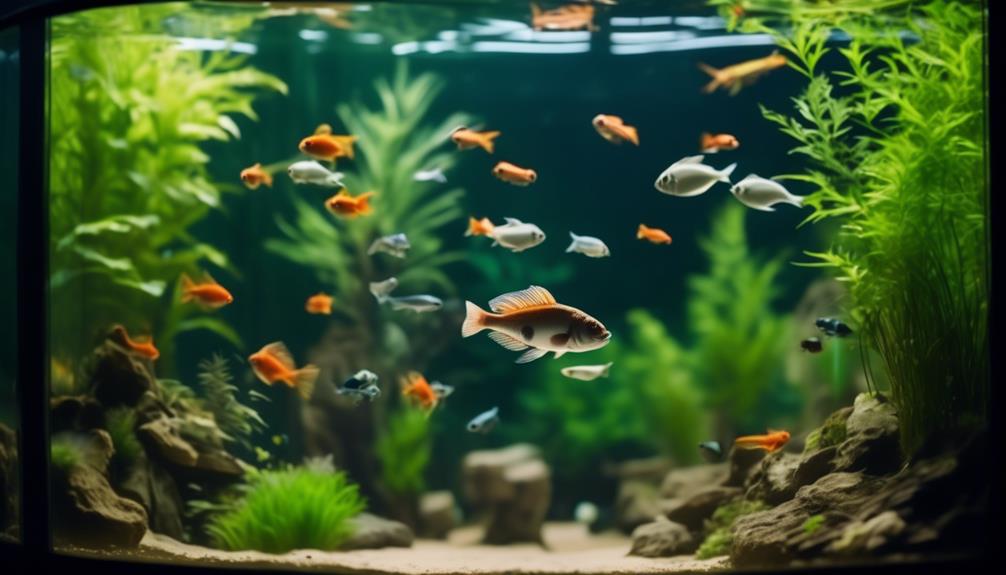
By creating a biotope tank that replicates the natural habitat of your fish species, you can provide educational opportunities that allow you to explore and learn about different ecosystems. Here are three ways in which biotope tanks can offer valuable educational experiences:
- Learn about specific ecosystems: Setting up a biotope tank requires researching and understanding the natural environment you want to replicate. This process allows you to gain knowledge about the unique characteristics, flora, and fauna of that particular ecosystem.
- Study fish behavior and interactions: Observing the fish in a biotope tank provides insights into their natural behavior and interactions. You can learn about their feeding habits, breeding patterns, territoriality, and social dynamics, which can be valuable for educational purposes.
- Promote conservation awareness: Biotope tanks encourage responsible fishkeeping and conservation efforts. By replicating natural habitats, these tanks raise awareness about the importance of preserving and protecting ecosystems and their inhabitants.
Through educational opportunities offered by biotope tanks, you can deepen your understanding of different ecosystems and contribute to conservation efforts.
Promoting Responsible Fishkeeping and Conservation
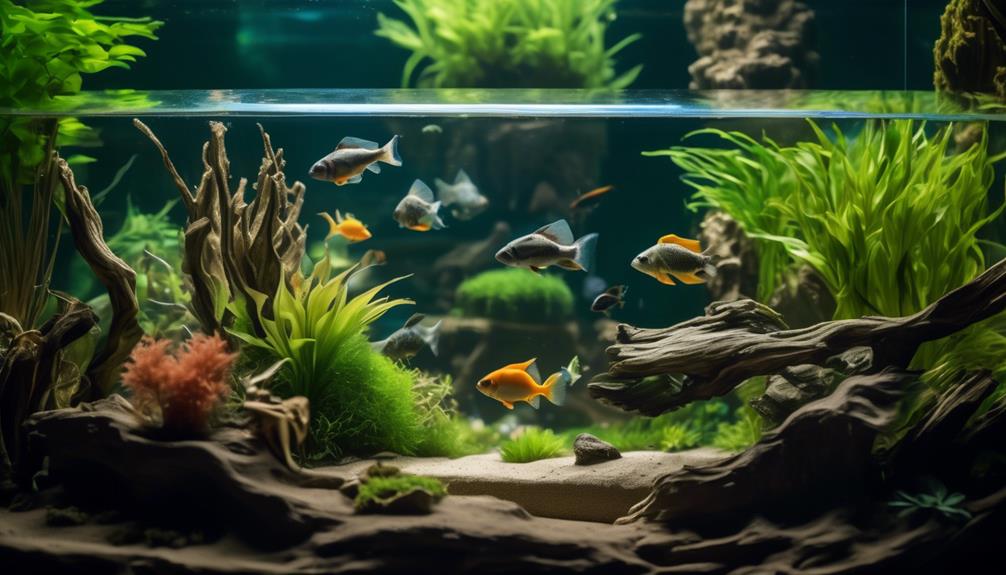
Promote responsible fishkeeping and conservation by understanding the impact of your actions on aquatic ecosystems. By being aware of how your choices and behaviors can affect the environment, you can play an active role in preserving and protecting our precious aquatic habitats. Take a look at the table below to learn about some key actions you can take to promote responsible fishkeeping and conservation:
| Actions to Promote Responsible Fishkeeping and Conservation | Impact on Aquatic Ecosystems |
|---|---|
| Properly research and select fish species for your tank | Prevents introduction of invasive species and overcrowding |
| Practice sustainable fishing and avoid overfishing | Helps maintain healthy fish populations and ecological balance |
| Maintain proper water parameters and quality | Ensures the well-being and health of fish and other aquatic life |
| Support conservation organizations and initiatives | Contributes to the preservation and restoration of aquatic habitats |
| Educate others about responsible fishkeeping practices | Spreads awareness and encourages others to make informed choices |
Researching Your Desired Biotope

To ensure the success of your biotope tank, begin by thoroughly researching your desired natural habitat. Here are three important steps to guide your research:
- Understand the ecosystem:
Learn about the specific natural environment you want to replicate in your tank. Study the water parameters, temperature, pH levels, and the types of plants, rocks, and substrate found in that habitat. This knowledge will help you create a suitable and authentic biotope.
- Choose appropriate fish and plants:
Select fish species and plants that are naturally found in your desired habitat. Consider their compatibility, size, behavior, and dietary needs. This will ensure a harmonious and balanced ecosystem within your tank.
- Mimic the natural conditions:
Replicate the water parameters and conditions of the natural habitat as closely as possible. Use appropriate filtration systems, lighting, and water treatments to create the ideal environment for your chosen fish and plants.
Thorough research is essential for creating a successful and vibrant biotope tank. Take the time to gather information and plan accordingly to provide the best possible habitat for your aquatic creatures.
Selecting Suitable Fish Species and Plants
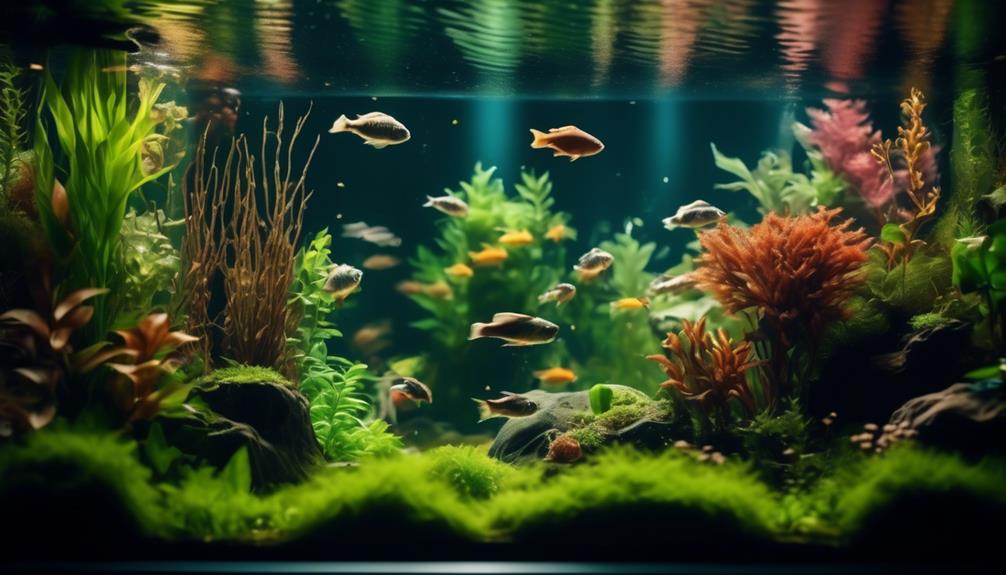
When selecting fish species and plants for your biotope tank, it’s important to consider their compatibility, size, behavior, and dietary needs.
Choose fish species that are known to coexist peacefully and have similar water requirements. Consider the size of the fish and make sure they’ll have enough space to thrive in the tank. Take into account the behavior of the fish, as some species may be more aggressive or territorial than others.
It’s also crucial to provide the right diet for the fish, including live or frozen food, flakes, pellets, or vegetables.
When selecting plants, opt for those that are native to the natural habitat you’re replicating, ensuring they can thrive in the specific water conditions and lighting of your biotope tank.
Mimicking Water Parameters and Conditions
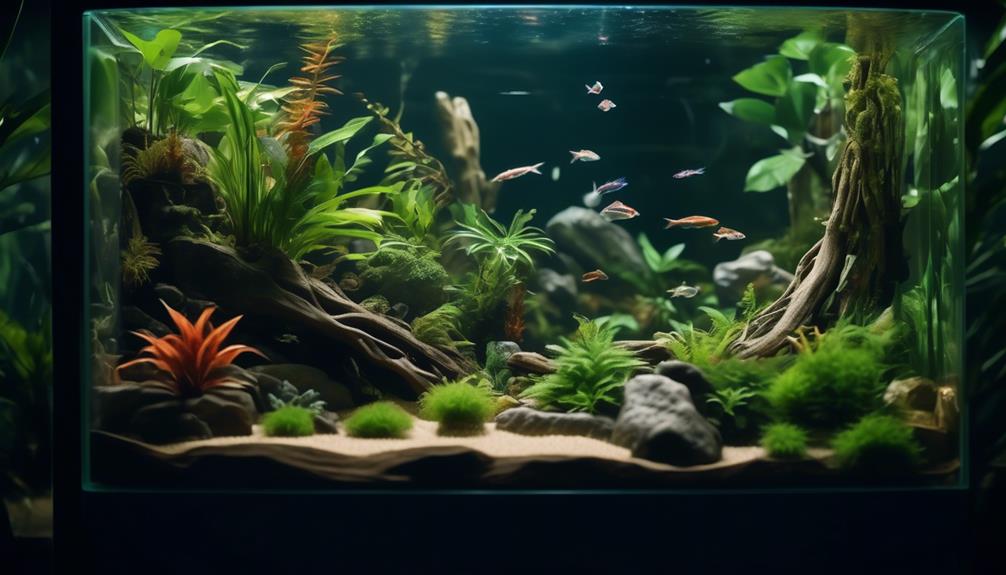
To accurately replicate a natural habitat in a biotope tank, it’s essential to carefully mimic the water parameters and conditions specific to the chosen environment. This will help create a realistic and thriving ecosystem for your fish. Here are three key considerations when mimicking water parameters and conditions in your biotope tank:
- Research the natural habitat: Understand the specific water parameters, such as pH, temperature, and hardness, of the environment you want to replicate. This information can be found through scientific studies and field research.
- Adjust water parameters: Use water testing kits to measure and adjust the pH, temperature, and hardness of your tank water to match the desired levels. This will help create a suitable environment for your fish.
- Maintain water quality: Regularly monitor and maintain water quality by performing water changes, using appropriate filtration systems, and ensuring proper oxygenation. This will help keep the water clean and balanced, promoting the health and well-being of your fish.
Choosing the Right Substrate and Decorations
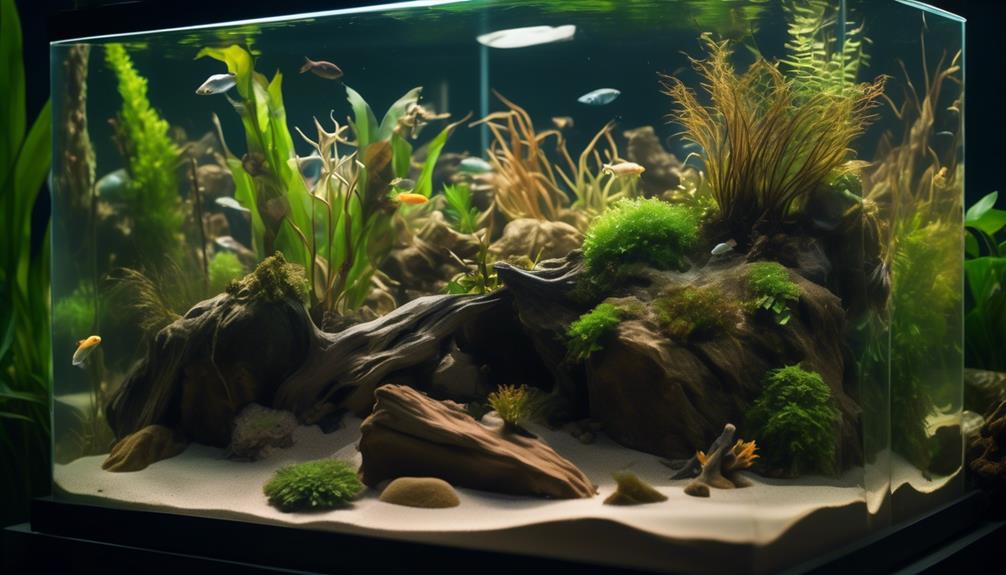
Now let’s dive into the important aspect of creating a vibrant biotope tank: choosing the right substrate and decorations.
The substrate you choose for your tank should closely resemble the natural habitat of the fish you’re keeping. For example, if you’re creating an African Rift Lake biotope, a sandy substrate would be suitable to mimic the sandy bottoms of rift lakes.
Decorations such as rocks and caves are also essential for creating hiding places and territories for your fish. These decorations should be selected based on the natural environment you’re trying to replicate. For instance, if you’re creating an Amazon River biotope, using driftwood and leaf litter would help recreate the diverse habitats found in the Amazon.
Maintaining Proper Filtration and Lighting
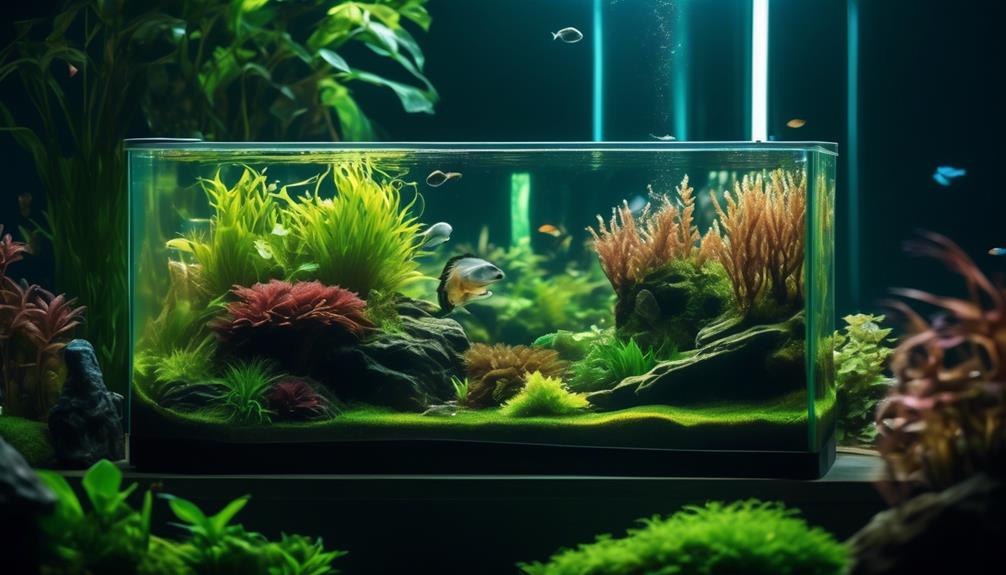
Proper filtration and lighting are crucial for maintaining a healthy and vibrant biotope tank. Here are three key factors to consider:
- Filtration:
Choose a filtration system that’s suitable for the size of your tank and the specific needs of the fish and plants in your biotope. A good filtration system will remove excess waste and toxins, ensuring clean and clear water for your fish to thrive in.
- Lighting:
Provide appropriate lighting that mimics the natural sunlight conditions of the biotope you’re replicating. Different fish and plants have varying lighting requirements, so research the specific needs of your chosen species. Proper lighting will support the growth of plants, enhance the colors of your fish, and promote their natural behaviors.
- Maintenance:
Regularly clean and maintain your filtration system to ensure its optimal functioning. Replace filter media as needed and perform regular water changes to maintain water quality. Clean the light fixtures and replace bulbs when necessary. By staying on top of maintenance tasks, you’ll create a stable and healthy environment for your biotope tank.
Amazon River Biotope Example
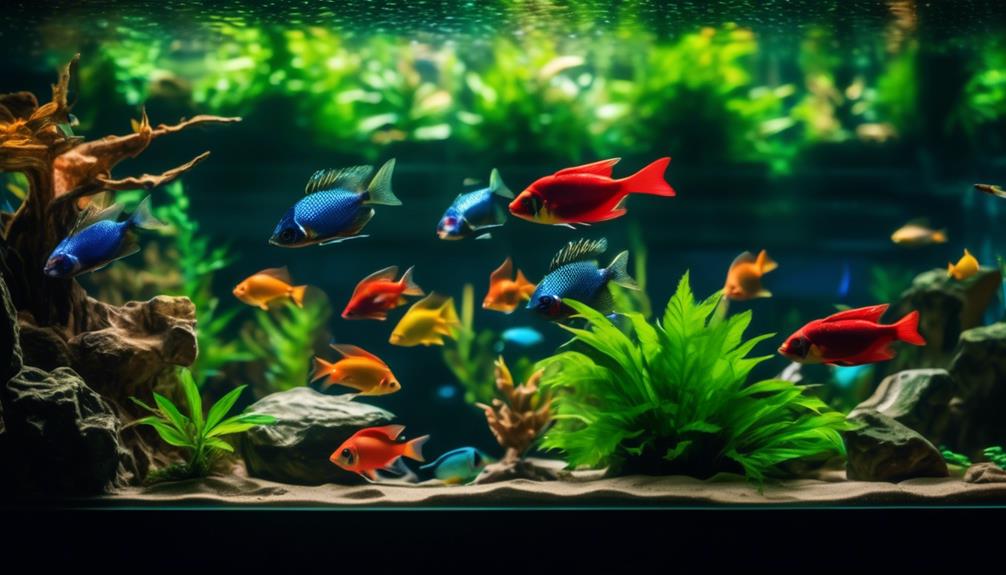
Creating an authentic Amazon River biotope in your tank requires careful selection of fish species and accurate replication of their natural habitat.
The Amazon River is known for its diverse and vibrant ecosystem, so it’s important to choose fish species that are native to this region. Some popular choices for an Amazon River biotope include angelfish, tetras, corydoras catfish, and discus.
These fish thrive in warm, soft, and slightly acidic water conditions, so it’s crucial to replicate these parameters in your tank.
Additionally, the Amazon River is filled with lush vegetation and driftwood, so incorporating live plants and adding natural decorations like rocks and branches will help create a more realistic and visually appealing habitat.
African Rift Lake Biotope Example
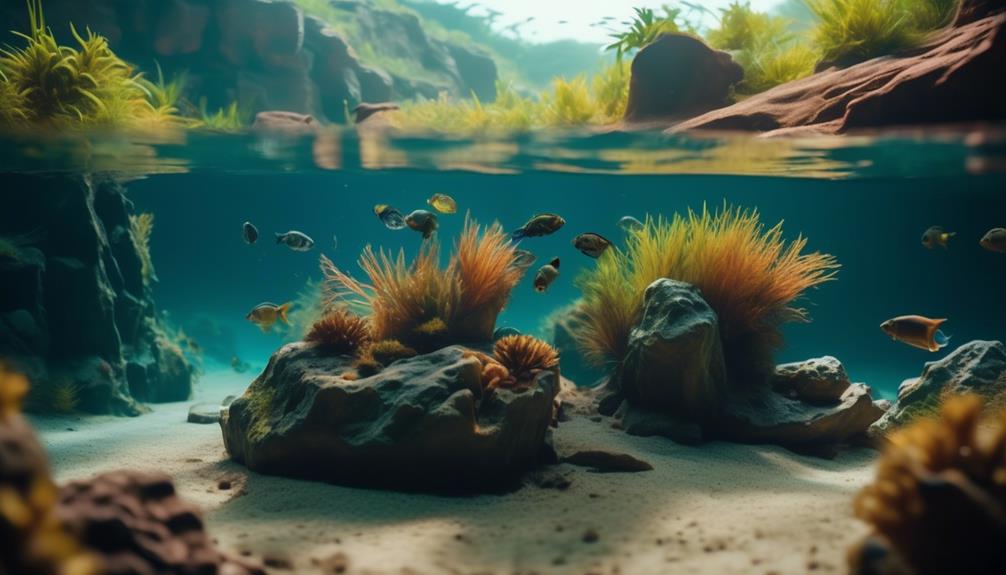
To create a realistic African Rift Lake biotope in your tank, carefully select fish species native to this region and accurately replicate their natural habitat. The African Rift Lake biotope is known for its rocky shores and sandy bottoms, so choose suitable substrate, rocks, and decorations that mimic this environment.
Here are three key considerations for your African Rift Lake biotope tank:
- Water Parameters: African Rift Lakes have specific water parameters that need to be replicated in your tank. Maintain a pH level of 7.8-8.6 and a hardness of 4-6 dH to match the natural habitat of the fish.
- Tank Setup: Decorate your tank with rocks, caves, and hiding places to provide shelter and mimic the rocky shores of the African Rift Lake. Create a sandy bottom by using fine-grained sand or substrate.
- Fish Selection: Choose fish species native to African Rift Lakes, such as Mbuna cichlids. These colorful and territorial fish thrive in large tanks and should be kept alone or with non-conspecific cichlids.
Southeast Asian Biotope Example
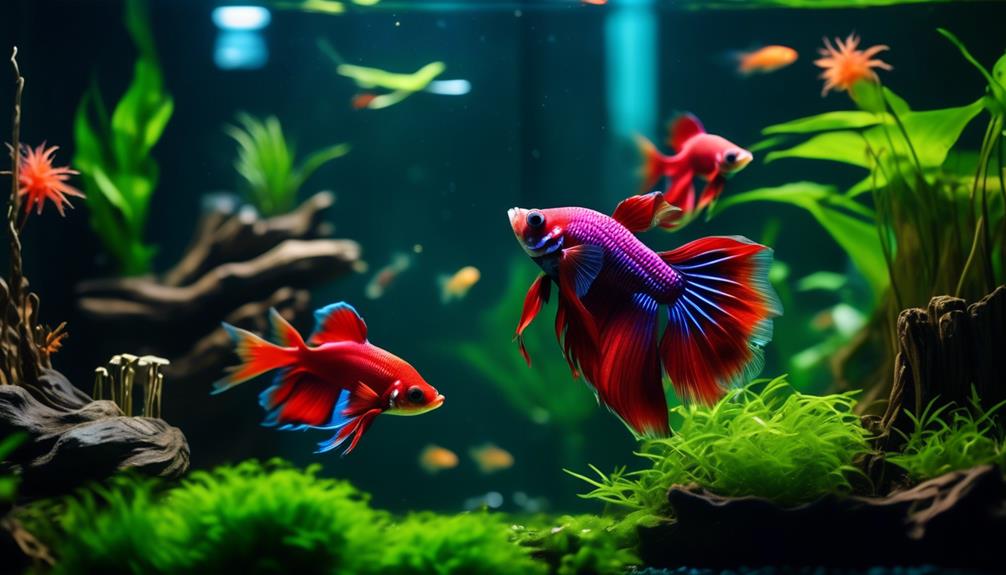
In Southeast Asian biotope tanks, you can create a vibrant and immersive aquatic environment that mimics the lush and densely planted rivers of the region. This biotope is characterized by an abundance of plants, including various species of aquatic plants and floating vegetation. The water in the tank should be slightly acidic to neutral, with a pH range of 6.5 to 7.5. It is important to maintain a temperature between 75°F and 82°F to ensure the well-being of the fish. Some popular fish species that can be found in Southeast Asian biotope tanks include the Siamese fighting fish (Betta splendens), pearl gourami (Trichogaster leeri), and harlequin rasbora (Trigonostigma heteromorpha). The table below provides a list of suitable fish species and plants for a Southeast Asian biotope tank.
| Fish Species | Plants |
|---|---|
| Siamese fighting fish | Java fern |
| Pearl gourami | Amazon sword |
| Harlequin rasbora | Water lettuce |
Australian Biotope Example
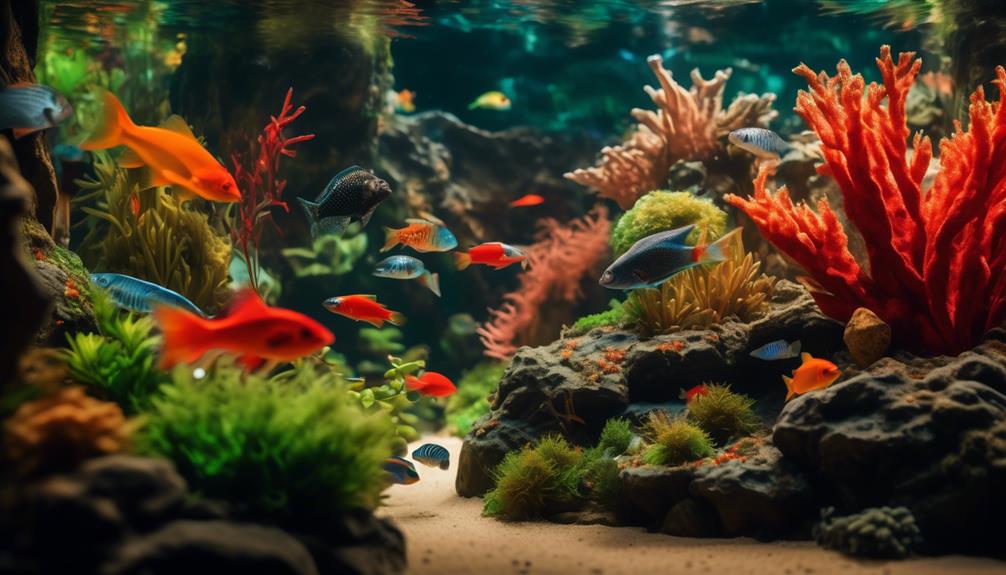
Immerse yourself in the vibrant aquatic world of the Australian Biotope Example, where unique ecosystems found in Australian waterways come to life. This biotope showcases the incredible diversity and beauty of Australia’s aquatic habitats.
Here are three key features of the Australian Biotope:
- Rich Biodiversity: The Australian Biotope is home to a wide variety of fish species, including iconic natives like the Rainbowfish, Murray Cod, and Barramundi. These fish, along with other unique inhabitants like freshwater turtles and crustaceans, create a thriving and dynamic ecosystem.
- Aquatic Plants and Structures: The Australian Biotope is characterized by its lush vegetation, which includes submerged plants, floating plants, and emergent plants. These plants not only provide shelter and hiding places for fish but also contribute to the overall aesthetics of the tank.
- Natural Elements: To recreate the authentic Australian waterways, the Australian Biotope incorporates natural elements such as driftwood, rocks, and sand. These elements mimic the natural habitats of the fish and create a visually appealing and realistic environment.
Frequently Asked Questions
How Do Biotope Tanks Benefit the Health and Well-Being of Fish?
Biotope tanks benefit fish health and well-being by reducing stress, improving behavior, and providing a natural habitat. They promote responsible fishkeeping, create visually appealing displays, and offer educational opportunities to learn about different ecosystems.
What Are Some Maintenance Tips for Keeping a Biotope Tank?
To maintain a biotope tank, regularly monitor and match water parameters to the natural habitat. Keep the tank clean with regular water changes and feed fish a varied diet. Prune and maintain plants to ensure they thrive. Understand the specific needs of the fish species.
Can Any Type of Fish Be Kept in a Biotope Tank?
Yes, any type of fish can be kept in a biotope tank as long as they are compatible with the specific natural environment being replicated. Research and choose fish species that thrive in that habitat.
Are There Specific Water Parameters That Need to Be Maintained in a Biotope Tank?
There are specific water parameters that you need to maintain in a biotope tank. Research the natural habitat of the fish you want to keep and mimic their water conditions for a successful and vibrant fish habitat.
How Can Plants Be Incorporated Into a Biotope Tank?
Plants can be incorporated into a biotope tank by selecting species that are native to the specific natural environment you want to replicate. Choose plants that thrive in similar water parameters and provide hiding places and natural grazing areas for the fish.
Conclusion
In conclusion, biotope tanks offer fish enthusiasts the opportunity to create vibrant and natural habitats for their aquatic pets.
These tanks not only promote the well-being and health of the fish, but also provide visually appealing displays that are educational and captivating.
By replicating specific natural environments, biotope tanks encourage responsible fishkeeping and conservation efforts.
So, dive into the world of biotope tanks and witness a lifelike underwater world right in your own home.




